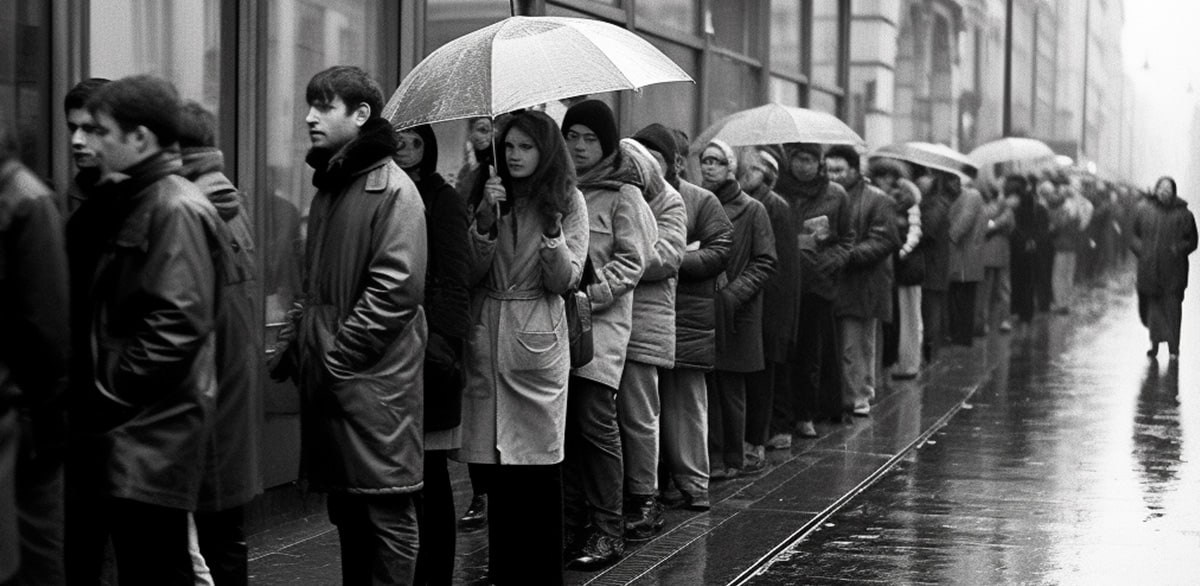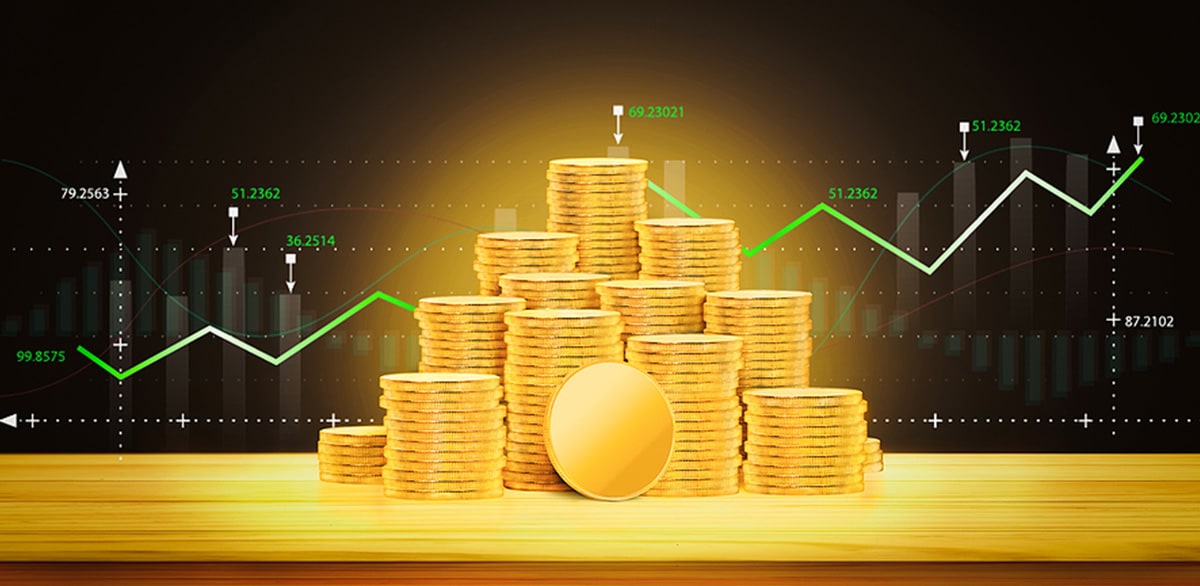
When a financial crisis is on the horizon, there is a notable point in time when people scramble to figure out how to save themselves and their money from the threat of financial instability. Times of uncertainty lead people to make hasty decisions, and bank runs are a result of this panic and vulnerability.
Currency collapses happen in slow motion at first. When the lack of confidence comes, it’s a waterfall effect and the currency collapses.–Sr. Precious Metals Advisor Damian White
What Are Bank Runs?
Bank runs are a form of financial panic, usually caused by rumors that a bank has insufficient funds to honor its deposits. The word “run” refers to a situation in which hoards of people try to withdraw their money at once, causing a bank’s reserves to be depleted.
Bank runs can happen when there is an actual lack of liquidity, but they can also occur when there is no actual shortage of funds at all. For example, if people believe that their money will be safer elsewhere or think that other banks are less likely than theirs to fail (because they’re bigger), then they may decide en masse to transfer their accounts from one institution into another–even though neither entity has any reason for concern about its solvency.
A Brief History of Bank Runs
Bank runs were more common before the digital age, as this type of financial panic was traditionally catalyzed by word of mouth and could not be disputed quickly. Once there were rumors that a bank was unable to release the full extent of a person’s funds, or if a theory had run rampant that the banks were due to fail, civil unrest would ensue. Thousands of people would line up and crowd the bank’s doors, demanding funds that the bank simply didn’t have.
Bank runs have happened globally since the beginning of banking. One of the first recorded bank runs happened in 1621, when citizens crowded a branch of the Medici Bank in Amsterdam to withdraw their money after hearing rumors that it had gone bankrupt. In 1797, a bank run occurred in New York City because people thought that President George Washington was going to take their gold coins away.
Another huge set of bank runs occurred in New York City in 1857, when people began speculating on a local bank’s closure due to the misappropriation of funds and a series of risky loans. The failure of the New York branch of the Ohio Life and Trust Company led to the “Panic of 1857”, ushering many banks into failure. With the invention of the telegraph, the news of this crisis and the general lack of confidence in the banking system spread wider and faster than ever, creating instability in the stock market as creditors began rapidly requesting payment, forcing investors to sell securities and tank market prices.
The Most Famous Bank Runs in the United States
The Great Depression – 1933
The Great Depression was a severe economic downturn that began in 1929 and lasted until 1939. It was the longest and most devastating depression ever experienced by the industrialized world. The Great Depression started in America when stock prices fell dramatically on October 24th, 1929. This event is known as Black Tuesday because it caused panic throughout Wall Street and investors rushed to sell their stocks at any price they could get for them. This led to more people selling their stocks which caused prices to drop even further than before, creating what we now call “a downward spiral”.
As stock prices continued to plummet, people throughout the nation rushed to secure their funds from local banks, as rumors circulated that these banks were refusing to sell stocks in full to those who requested them. In fact, over 9,000 banks failed during the Great Depression, wiping out the savings of millions of Americans.
On November 14th, 1930, hundreds gathered at the entrance of Tennessee Hermitage National Bank in Nashville, TN, demanding their funds be released in full. Though the bank assured everyone that they would receive all their funds, it became clear that by the end of the day, even in consolidation with the Commerce Union Bank, it would be impossible to liquidate funds for all customers. This caused thousands of people to lose all of their money, and it served as the first in a series of bank runs that helped force the country into a decade-long stretch of national poverty and financial ruin.
To earn and retain money during the Great Depression, people had to get creative. Some turned to growing their own food and selling excess crops. Others took on odd jobs, such as selling goods door-to-door or doing manual labor. Some people invested their money in government bonds, hoping for a safe and reliable return. Others put their money into stocks, hoping to make a quick profit.
It is clear that people have always collected gold as a means of wealth protection, so much so that in 1933, President Roosevelt signed Executive Order 6102. This order demanded every citizen turn in their gold for cash since gold hoarding had caused legitimate stress on the economy at the time. The government needed a large influx of gold in order to produce and introduce more paper money into the economy. This became a serious issue for Americans, as they were faced with the responsibility of sacrificing their gold for the benefit of the country’s financial health. It wasn’t until 1974 that Americans were able to purchase and own gold again, giving them the long-criminalized opportunity to secure this asset and their personal wealth.
2008 Financial Crisis and Bank Runs
The 2008 financial crisis was a catastrophic event that shook the global economy to its core. It was triggered by a combination of factors, including lax lending standards, excessive risk-taking, and a housing bubble that burst. The crisis led to a bank run that threatened the stability of the financial system, causing panic among depositors and investors alike.
The United States had the luxury of avoiding a bank panic for over 70 years due to the security measures put in place in the wake of the Great Depression. Federally-backed deposit insurance programs encouraged national faith in the banking system yet again, discouraging massive bank runs for decades.
The bank run during the 2008 financial crisis was a sequence of events that began with the failure of Lehman Brothers, which was one of the largest investment banks in the world. This bank met its demise with its involvement in subprime lending, which consists of offering loans to individuals with low income or bad credit at above-prime interest rates. From 2007-2008 there was an all-time high in mortgage defaults, as those with subprime mortgages could not keep up with the astronomical payments. The Lehman Brothers claimed this burgeoning mortgage crisis would not disrupt their banking proceedings or investment portfolio. Ultimately, the investment bank giant did not capitalize on the evolving equity markets in late 2007 and neglected to adjust their portfolio, which consisted disproportionately of mortgage securities. This event triggered a wave of panic among investors, who started rapidly selling their stocks and withdrawing their funds from other banks and financial institutions. This led to a liquidity crisis, as banks struggled to meet the demand for cash withdrawals.
The impact of the bank run was felt throughout the economy and the banking industry. It led to a credit crunch, as banks tightened their lending standards and reduced their exposure to risky assets. This, in turn, led to a contraction in economic activity, as businesses and consumers found it harder to access credit. The ripple effects of the crisis were felt worldwide, as it spread to other countries through the interconnectedness of the global financial system.
The lessons learned from the 2008 financial crisis and bank runs have led to significant changes in regulations and policies aimed at preventing similar events from occurring again. The Dodd-Frank Wall Street Reform and Consumer Protection Act, for example, introduced a range of measures to enhance the stability of the financial system, including stricter regulations on banks and financial institutions, and the creation of new regulatory bodies to oversee the industry.
Silicon Valley Bank Run – 2023
The recent collapse of Silicon Valley Bank, triggered by a digital bank run, sent shockwaves through the tech industry and the broader economy. The bank’s collapse has highlighted the fragility of the financial system and the looming threat of an impending recession.
The Silicon Valley Bank run was triggered by a variety of factors, from the rapidly declining value of US government bonds and ballooning interest rates, to an overreliance on the tech industry. As a result, people began withdrawing their deposits from Silicon Valley Bank, leading to a liquidity crisis and the eventual collapse of the bank.
As with any other bank, SVB invested customer deposits into long-term US government bonds, whose value began to rapidly decrease amidst accelerating interest rates. The bank found it difficult to provide liquid funds to all of its customers, as interest rates have an inverse effect on bonds. Once word got around that investment firm Founders Fund began moving their money out of SVB, others began to do the same, bolstered by a digital panic that took place on platforms like Twitter.
The collapse of Silicon Valley Bank and the impending recession serves as a reminder of the importance of protecting one’s finances. Physical investments like gold can play a crucial role in achieving this, providing a safe-haven during economic downturns and diversifying investment portfolios. It is essential to take proactive steps to protect one’s finances and be prepared for any eventuality.
Investing in Precious Metals: Protecting Your Financial Interests During Economic Turmoil

Investing in precious metals like gold, silver, and platinum has been a popular strategy for investors looking to protect their finances during times of economic uncertainty and market volatility. Precious metals are considered a valuable asset class because of their scarcity, durability, and intrinsic value.
During times of economic uncertainty, precious metals can act as a safe- haven investment that can help protect against currency devaluation, political instability, and market crashes. Precious metals have been used as a store of value for thousands of years, and they have a track record of preserving wealth over the long-term. By investing in precious metals, investors can maintain their purchasing power and protect their portfolios from the effects of inflation.
The price of precious metals is affected by a variety of market factors, including inflation, supply and demand, and geopolitical risks. During times of market volatility, precious metals tend to perform well because they are not correlated with other asset classes like stocks and bonds. This means that investing in precious metals can help investors achieve a balanced portfolio, reducing their overall risk exposure.
Gold is a safe-haven investment that has been used for centuries as a store of value. It is not correlated with other assets, meaning that it tends to perform well during economic downturns. Gold has a track record of retaining its value over the long term, making it an attractive investment option for those looking to protect their finances.
According to the World Gold Council, gold prices tend to rise during times of economic uncertainty. During the 2008 financial crisis, for example, gold prices experienced a 16.3% nominal increase. During the COVID-19 pandemic, gold prices have again risen, reaching record highs in 2020. This demonstrates the resilience of gold as an investment option and its ability to provide a hedge against economic turbulence.
👉 Related: What to Own If the Dollar Collapses (Hint: NOT Paper Assets!)
Safeguard Your Finances Today
As part of an overall investment strategy, investing in precious metals should be considered by investors looking to protect their finances from market turbulence.
As the worldwide financial crisis continues, it’s becoming increasingly clear that investors need to protect their retirement savings. The status quo is not going to last forever, and those who do not look to diversified investment vehicles like physical gold may end up losing a lot more than they realize. By diversifying and looking toward hard assets, such as precious metals, you can help protect yourself from major market fluctuations in this tumultuous climate.
If you’re interested in learning more about the benefits of precious metals, request our FREE gold and silver Investment guide.


